A flash drive is write-protected how to format it. Remove write protection with Diskpart. - Local access policies
Having a problem with a write-protected flash drive? Not sure how to unlock the flash drive, make it available for reading? You are trying to write some file to a usb drive or sd card, and in response you receive a message: “the flash drive is write-protected”. If you urgently need to copy files to a disk or flash drive, I will show you how to unprotect and format (or clear) the storage medium - for further work, familiar and correct.
Restoring access to the flash drive through the Registry
The first method of removing write protection is fairly simple, but requires minimal skill and careful handling of the registry editor. If you are not 100% sure of your actions, do it using RegOrganizer.
1. Open the registry editor (Start - regedit). You need to run regedit as an administrator.
2. Change directory to HKEY_LOCAL_MACHINE \\ SYSTEM \\ CurrentControlSet \\ Control \\. If you cannot find the StorageDevicePolicies branch under this folder - create your own. For this:
3. Go to the HKEY_LOCAL_MACHINE \\ SYSTEM \\ CurrentControlSet \\ Control \\ directory again and click right click by folder control
4. Select New - Section, then rename the newly created Registry section to StorageDevicePolicies.
5. Right-click on StorageDevicePolicies and select the new value of the DWORD (32-bit) parameter for the 32-bit OS or DWORD (64-bit) for the 64-bit OS, respectively.

6. Rename the dword parameter to WriteProtect, double-click on it, specify the value 0 in the HEX, then close the Registry editor.
7. Open My Computer and refresh the window 5 times without touching USB drivethen safely remove the USB flash drive. To fix the results you need to restart the computer.
8. Insert the USB flash drive into the slot and format the protected disk or the entire USB flash drive if necessary.
Another solution to unprotect from disk: use diskpart utility
diskpart is a console utility included in Windows XP and higher that allows you to flexibly manage hard disks, file volumes and partitions at an in-depth access level.
We will try to access the problem flash drive via the console, and then format the write-protected flash drive.
1. Open command line (cmd.exe). Enter "diskpart" to open the utility.
2. Enter "list disk" to display a list of available disks in the system.
3. Determine where in the list is your USB drive. Enter "SELECT DISK n", where n is your USB flash drive with a write-protected disk.

Be very careful! Wrong media selection will cause you to lose all data on the selected drive.
4. Type "clean", (you may have to repeat this command twice or three times). If nothing works, try other ways to unlock the flash drive.
5. Enter "create partition primary" to create a new partition on the usb flash drive.
6. Type "select partition" to select a partition on the disk.
7. Enter "active" to make the disk active.
8. Enter "format fs = ntfs" for formatting in NTFS (before formatting a USB flash drive, make sure that you select the correct storage medium!).
By the way, the option with diskpart is one of best practices format the flash drive, write-protected, without resorting to third-party tools.
Another way to remove protection from a memory card / flash drive. Diskmgmt.msc utility
The protection removal method is suitable for both sd memory cards and usb flash drives. We will need a standard Windows component for disk management - diskmgmt.msc.
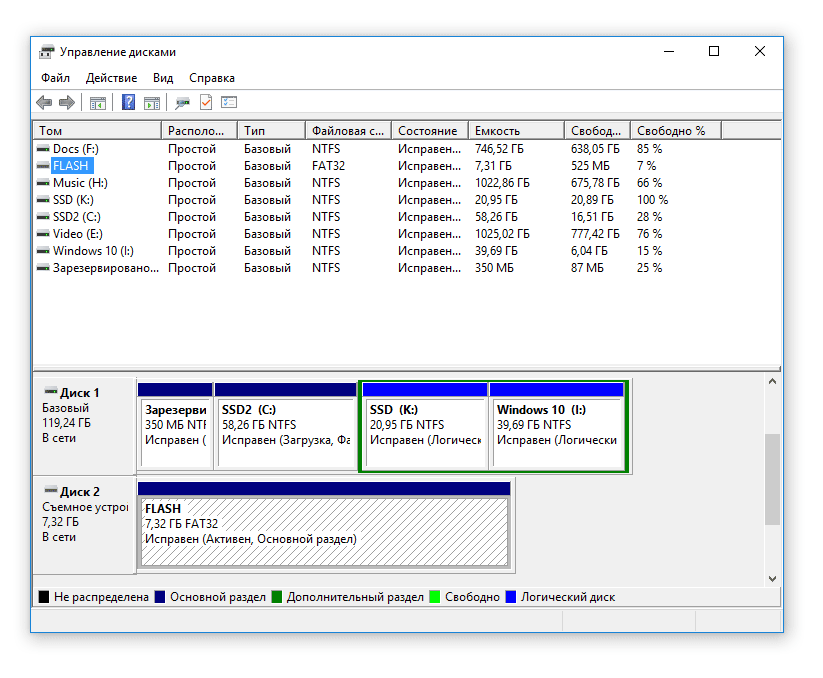
- Start - Run. Type diskmgmt.msc in the text box and press Enter.
- The right button on the section that you want to format (the letter and section will help determine)
- Select "Delete Volume ..." and confirm the operation.
- AT context menu select the "Create volume" command
- Select primary partition
- All parameters leave the default
- Press ok
Remove protection from a flash drive through the Windows Group Policy Editor
In some cases, access to the flash drive is limited by the rights of the local group policy Windows We tell how to remove protection in a similar situation:
- Start - Run - gpedit.msc.
- In the panel that opens, go to the next section: "Computer Configuration - Administrative Templates - System - Access to Removable Storage Devices".
- Next, you need to deactivate the option "Removable drives: Disable reading" by switching to the "Disable" state.

Other working methods for removing write protection files
If none of the above recipes helped - well, other methods are likely to work, how to unprotect a flash drive (over time, the list will be updated).
- Check your flash drive for viruses. Some malicious applications establish their own control over the files, as a result, the USB flash drive is protected from writing data belonging to viruses. How to remove protection in this case? We recommend to use for scanning.
- Check whether there is a hardware button on the flash drive that allows you to unlock it physically (there is a switch on the side that needs to be moved towards the open lock). However, today similar usb flash drives and sd cards are very rare - mainly, these are old models of devices.
- Update your flash drive firmware, find the exact model in Google by chip vendor and chip vendor model, see Device Manager.
- Some flash drives come with proprietary software. So, for Transcend there is a program JetFlash Recovery, and it is quite suitable for correcting read and write errors on flash drives of a specified manufacturer.
- In the extreme case, try to forcefully format the usb flash drive, resorting to such formatting utilities as or.
Conclusion. Although it is not always possible to determine why the flash drive is write-protected, of the many methods described, at least one is working. If none of the ways to remove protection from the USB flash drive has helped you, it remains to replace the usb drive - in other words, buy a new one.
However, ask questions on the topic - you can do this through the sidebar on our website. We will try to help.
Question answer
32 gig WANSENDA USB flash drive with formatting. When you try to delete any file, it asks you to remove the write protection from the disc or use another. What to do, how to remove the write protection? I can not delete or throw files on a USB flash drive.
Answer. Try to remove write protection from a USB flash drive through the Registry, using diskpart or diskmgmt.msc. Format the USB flash drive with Low level format or Disk format tool.
All formatting attempts give me one result: unprotect, the card is write-protected. She took off her defense in all sorts of ways, but she comes back, I can’t do anything. The phone provides information about the card malfunction and can not format it in any way. The computer and laptop are accepted, but formatting fails.
Can you tell me what to do, how to remove protection from an sd card? Other phones and digital camera did not help.
Answer. Try to reset the protection in the ways described in the article and immediately format the memory card in FAT32. Check if there is a switch on the sd card (it may be installed in the wrong position, so the memory card is write-protected).
I can not format a SONY 64GB flash drive, copy and delete files on it. The system says that the disk is write protected. What to do? I tried everything that you have. Does not help. Flush bought in mvideo, about 3 months ago, worked before this regularly.
Answer. Some users to remove protection helps proprietary utility JetFlash Recovery. It allows you to format the flash drive at a low level of access. If it does not help, try removing the write protection from the disk through the registry or command line. After that, restart the computer.
I have a Samsung S3600 phone, I stopped writing files to the card. The most interesting thing is that there are two photos and one video left on the map - there is no way to delete them at all. They are deleted from the computer, but then they appear again on the map. I can not write anything on the card - at first everything seems to be there, but on the phone there is nothing ... as it is. I didn’t drop my phone, I didn’t stop it, just suddenly the card stopped working, and it was also so bizarre. He sees the card, but does not write anything on it and does not delete anything from it ... How to remove write protection on a USB flash drive?
Answer. You can remove the write protection on the flash drive via forced formatting. This can be done through the console utility diskpart for Windows or all sorts of graphical utilities like the SDFormatter or the Hp disk format tool.
The files may not be deleted due to errors in reading the sectors to which non-deleted files are written. You can check the USB flash drive for errors through Properties - Tools - Check in Explorer.
After the navigator with ADRplayer, I cannot delete files from the SD card (including write-protected). On Windows, it is recognized as a 118 MB disk with the ADRplayer program on it. Files are all played by this program. Formatting in Windows is not possible.
Answer. Since the sd-card drive is write-protected, you need to format it to NTFS using the command line (using the diskpart utility) or using the system utility diskmgmt.msc. In addition, there is a wonderful program for sd-cards called SDFormatter - it removes write protection.
it is unclear what happened to the flash card, when you connect the card to a computer, you get “To use the disk in drive J, first format it.” You start formatting in fat32 format without being cleaned quickly and tried quickly, writing the disk is write-protected. I tried the described The options did not help.
The way through diskmgmt.msc after right-clicking on the flash drive does not allow "delete volume" and other actions are simply not active. The file system of the flash card is Raw, and the system writes that it is working. What to do, how to remove write protection from a USB flash drive, reanimate it?
Answer. In addition to diskmgmt.msc, try to remove the write protection on a flash drive using the Registry or using the diskpart console utility. For formatting, use not standard tools Windows, for example, Low level format. If after these manipulations the disk is still write-protected, try opening the USB flash drive in another operating system, use third-party software to manage the disks on the USB flash drive - say, Acronis Disk Director.
I bought a mini sd for a 128dig SanDisk phone. I insert into the phone Samsung galaxy A5 (2016), will work for some time and then it blocks the recording on it. that he did nothing: and formatted it through the PC, and through the phone, it was all useless, it would work for some time, then it would block the recording again. How to format a secure flash drive?
Answer. The file table may be damaged on the memory card, which makes it impossible to write new data. In such cases, it is recommended to check the disk for errors through the standard chkdsk tool (Start - Run - chkdsk). If it does not help, format the sd card through the sd formatter desktop application. Judging by the reviews, the utility has helped many users when formatting a flash drive. You can also format the sd card through the Recovery menu by rebooting the phone in the appropriate mode and selecting the option Wipe cache partition.
I ordered a USB flash memory from the Internet. I initially formatted it, but I didn’t like that she didn’t read and saw all the formats. I decided to format it completely, without a tick, only (table of contents). Now the laptop with Windows 10 OS sees it, but requires formatting it. I format, but the flash drive is not formatted - the disc is write-protected. I was already trying to do something (download programs), but I don’t understand, but I’m still far from it.
Answer. In your case, formatting a usb flash drive is preferably not using standard Windows tools, I am using specialized software - the benefit is that the choice is wide. First of all, look for programs specifically for your flash drive on the manufacturer's website. If not found, use HP USB Disk Storage Format Tool or any disk manager like Acronis Disk Director. As a file system, specify NTFS or exFAT.
1) Sandisk ultra USB 3.0 flash drive for 16 GB. I tried everything from renaming a letter to cleaning the registry. As soon as you start formatting (including through the management of partitions), a message pops up that Windows can not do this and the flash drive disappears from the field of view. I also tried HDD Low Level Format Tool v4.40 Final - the same thing happens as described above. How to format a write-protected flash drive?
2) I can not format a micro SD card. He writes: “Windows could not complete the formatting.” I tried using different programs and the command line. I’m not formatting anyway. I just can’t delete files. I click “delete”, removed the USB flash drive and put it back. The file that I deleted is there again I can not delete or format.
Answer. Try other programs for formatting: SDFormatter or software available on the developer’s site (sometimes you can format a USB flash drive bypassing them system errors). In addition to Disk Management, you can use any disk manager like Partition Magic or Acronis Disk Director.
You can also assume that the problem is related to Windows or the configuration of the computer. Try to format the USB flash drive on another computer or in another OS environment (Windows / Mac OS / Linux).
Most users have flash drives (usb sd, transcend, microsd, kingston, sandisk, cd, flash, qumo, microsd, apacer, verbatim, sdhc, psp), hDD d (hdd), dvd or any other removable or local drive.
Surely you use them with great regularity. They allow you to copy your media, photos and important documents.
Despite the high resistance to mechanical damage and the ability to store data for many years, like all other gadgets, they deteriorate.
One of the most common errors that can touch USB flash drives, memory cards or disks is an annoying message: the error is "Disk is write-protected."
Those who have ever been similar problem know very well what i mean.
The inability to copy / add / delete any files - this can lead to frenzy.
After strenuous attempts to repair, in the end, the majority refuse to fix and buy new ones.
What if the system writes the disc is write protected? How to remove this notorious protection?
Here are a few simple ones. effective solutions restore a disk or USB flash drive to a healthy state.
Use these simple tips and tritely forget about the message: “the disk is write-protected”, although there is one moment here that I had to face more than once.
- ATTENTION! Did you know that the built-in memory capacity of flash drives can be easily increased. Most of this does not even suspect.
The thing is in the microprocessor. If it fails, even partially - you can read - copy or format - no), then only a utility from the manufacturer of the drive can fix it and not always.
Getting Started to Unlock Disks and Flash Drives
You have a USB flash drive connected to your computer, and you want to copy some files.Here you will find a surprise “The disc is write-protected. Remove the write protection or use another disk. "
Then you say, "... your mother, how did it happen?" Do not panic - take a deep breath and keep calm.
This is just an error message. Now we will go through a few simple steps together to remove write protection on a USB flash drive. This is just technology and much we can fix.
Step 1 - Check the USB drive for viruses
Every time you plug in a USB drive to your computer, you should automatically scan for viruses — especially if you used it on computers you don't own.
Viruses often populate USB disks with their files - this can cause a message: write-protected.
Depending on the antivirus softwareIt can be configured to automatically scan USB drives when they connect. If not, perform such a tool manually.

If you find a virus, then eliminate it with antivirus software.
Most likely, where there is one virus, there are two or more. For such work, good recommendations have free utilities Doctor Web and AVG.
Step 2 - Check the USB stick case
Some USB flash drives are equipped with a mechanical switch that allows you to put them in the protection position from the recording mode.
This may be a very small slider switch, which can independently switch in your pocket or computer case (if it is an adapter).
If this is your situation, simply turn the switch to the open position and try copying the files again.

Today there are not many USB drives with such locks. So there is a good chance that this is not your problem.
On the other hand, if it is not a question, then the following fixes are a bit more complicated.
Step 3 - Make sure the disk is not full
If your USB drive is full, you may also receive a write error message.
Therefore, find your USB drive, right-click on it and select "Properties".
This will give you a good pie chart: how much is used and how much free space is available on your disk.
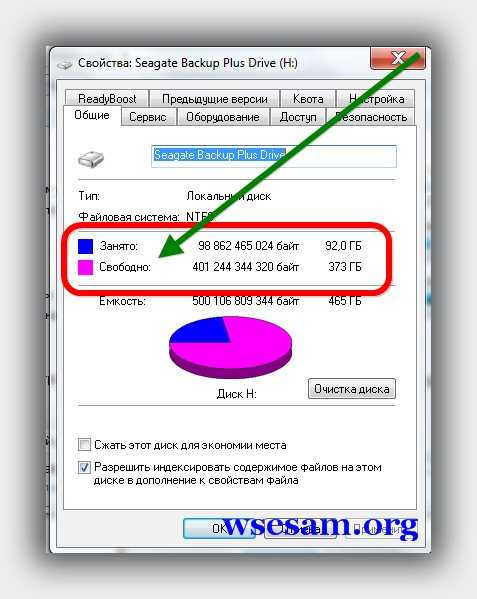
Step 4 - File System
Make sure you do not use a file that is write protected. Yes, you will receive another error message, but you may have made hasty conclusions and thought that the entire USB flash drive was locked. This happens.

Right-click on the file you are trying to write, and then on “Properties” and the “Security” tab.
You will now see several options at the bottom of this window, and one of them is read only.
Make sure that the checkbox is not checked or clear, and then click on the apply button. You should now be able to write to this file.
Step 5 - Diskpart command line utility
Have you ever worked on the Windows command line? This is not as scary as one might think, and as such it is the next logical step to unprotect.
Click on and enter the word CMD in the field: search for programs and files.
Now, click the top on (black icon). You will see the following window:

Type in the command - DiskPart - and press Enter. Diskpart is a tool that is built into Windows and is available through the command line utility. With it, we can change the values associated with your USB drive.
![]()
Make sure that this is really your USB drive. Now enter the Select Disk 3 command, it is assumed that your USB is the number 3, and hit Enter.
Now insert another command — disk clear ReadOnly — and then click on Enter.
In this way, you have cleared all the read-only attributes that can be on this USB drive.
Now close the command prompt and try to write to the USB disk again or again. If the protection continues to block access go further.
Step 6 - to the registry
If none of the previous actions helped you, then you must do something a little dangerous — enter the registry.
If you are not satisfied with the registry, you can proceed to step 7 to format the USB disk.
Or maybe you have a friend who is a computer technician and will check the registry for you.
Try it yourself - this is a fairly simple registry change, and you can do it.
Click on the "Start" menu and enter the command - regedit - in the search box for programs and files. You will see something like a picture in the box below.

Click on the top icon and the registry editor window will open. When you click on the arrows next to the menu items, go to the branch
HKEY_LOCAL_MACHINE \\ SYSTEM \\ CurrentControlSet \\ Control \\ StorageDevicePolicies
and find the key with the name - WriteProtect.

If such an entry exists, right-click on it and click on "Edit".
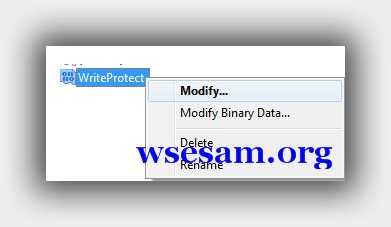
Now, you will probably find that this parameter is set to 1. 1 means “yes”, and “0” means no. Now change the value to 0 and click on the OK button.
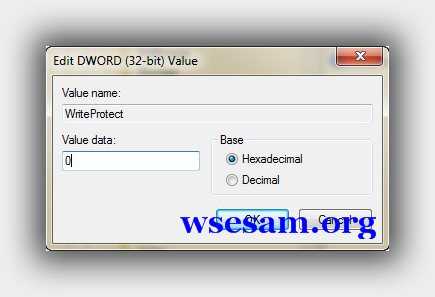
Close the registry editor, remove the USB device, and then plug it in again. You should now be able to record to your USB drive. If not, the disk will have to Format.
Step 7 - Format the USB Disk
WARNING: make sure you do backup all files and information from your USB drive. All data after formatting will be lost.
Formatting hard drive is the last resort. However, it must ensure that your USB is able to read and write.
Before formatting a USB drive, determine which file system it already has - NTFS or FAT32.
Usually the file system that he already has will be best suited for him.
Now right-click on the selected USB drive and select "Properties" - there you will see the file system.
Close the "Properties" window, right-click on the USB drive again and select format.
This describes the built-in windows tool, but sometimes it is advisable, especially if the integrated functions did not bring the desired result.

In the Formatting window, you have several options. You have already determined which file system you will format.
I suggest unchecking the Quick Format box. It will do more than erase files.
If there are bad sectors on this USB drive, full format will give an error.
Formatting should not take a lot of time. Of course, the larger the volume, the longer it will take.
If you assume that you do not have a physical problem with the disk, then it will be formatted and ready to read and write.
Conclusion
Sometimes the problem is simple and can be viewed simply. Try the methods above because they are most often correct.
If the problem is deep and requires decisive action, make sure that this is true.
Now you have a lot of troubleshooting tools in your arsenal, and you need to repair your flash drives and disks, potentially saving a tidy sum of money.
Of course, if you have any additional tips, we would like to read them too. Successes.
Keywords: usb sd, transcend, microsd, kingston, sandisk, cd, flash, qumo, microsd, apacer, verbatim, sdhc, psp, external, flash drive, dvd.
A guide to removing write protection from a USB stick.
Navigation
USB flash drives and microSD memory cards are widely used for temporary storage of data. Files stored on them are easy to delete, but they often leave behind a lot of invisible garbage that litters the memory and slows down the reading of information on a USB drive. For deep memory cleaning, users resort to formatting flash drives. But, quite often, during the formatting of the flash drive, a notification pops up that says that it is write-protected.
In our article we will try to figure out how to bypass the protection of a locked flash drive or memory card.
A similar message about the security of the disk can pop up for various reasons and not only when trying to format a USB flash drive. It so happens that the USB-drive served you for a long time faithfully, but one day when you try to transfer files to it or vice versa to take them from it such a notification appears. Consider the main reasons why this trouble can happen:
Physical blocking

- Many USB flash drives and memory cards have a small fuse on their case. It is a standard slider switch that is easy to overlook. If you move the switch to a certain position, it will play the role of a fuse and will not allow you to accidentally delete data from a flash drive. Carefully inspect the flash drive body for a slider switch. If it is, move it to another position and try to repeat the procedure for deleting files from a USB drive.
New flash drive

- If you purchased a new USB flash drive or microSD card, and in the process of writing files to it, a message about the disk security pops up, then it is most likely that your device was previously formatted in ancient file system FAT32. To clean up the file system, it will need to be formatted NTFS. We will tell about it a bit later.
- Other possible reason this error occurs when using a new flash drive - a virus. Before you, the sellers of the salon where you bought the USB flash drive could use the drive and add a harmful program to it. Just in case, scan the computer and the USB flash drive for a virus with any available antivirus.
Physical damage
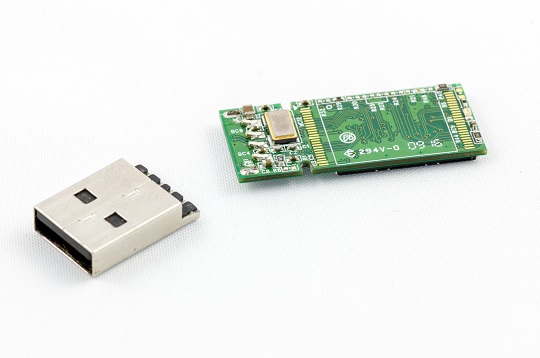
- Quite often, the reason for the notification " The disc is write protected."Associated with physical damage to the drive. Perhaps due to the strong impact of the device on the floor, contact has fallen off or microcracks have occurred. The worst-case scenario is damage to the memory chip from impact or normal wear. If, in the case of a loose contact, you can recover data from a flash drive using special equipment, then with a damaged chip, you can say goodbye to them.
How to format a write-protected USB flash drive using standard Windows operating system tools?
Before resorting to the use of third-party software, you must try to break the write protection using the tricks of Windows. Alternately, do the following:
- Step 1. Expand the " StartRun". In the startup window, enter " cmd" and press " Enter"To activate the command line.

- Step 2. In the window that opens, you will need to write the command “ diskpart"And click" Enter"To start a service that works with computer disks.

- Step 3. A new window will open where you need to write the command “ list disk"And click" Enter»To display existing hard disk and USB partition. Your flash drive must first be connected to the computer.

- Step 4. A list of partitions of the hard disk and connected storage devices will appear on the monitor, each of which is assigned its own digit. In the same window write the command “ select disk H", Where instead of" H»It is necessary to put the number under which your flash drive is located. Click " Enter».
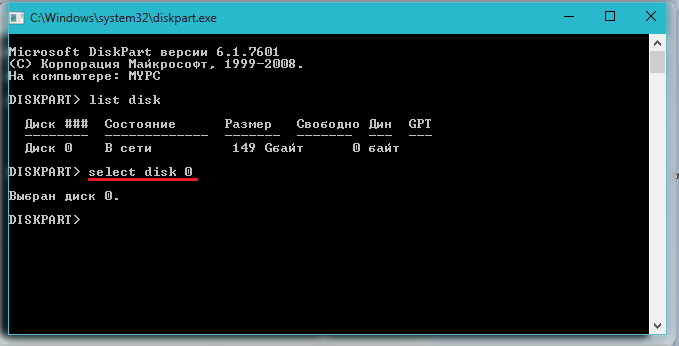
- Step 5. After the flash drive is selected, enter the command " attributes disk clear readonly»To clear its attributes. Remember that all files from it will be erased. Click " Enter».
- Step 6. Next, enter the command " clean" and press " Enter"To clean the disk.
- Step 7. Since the flash drive has a file system format FAT32, we need to reformat it into a format NTFS. To do this, write the command " format fs = ntfs" and press " Enter».
- Step 8. The flash drive is formatted and now it remains to assign a letter to it, under which it will be displayed on the computer. To do this, write the command " assign letter = K" and press " Enter". Instead of " K»You can set any other letter.
In that case, if this procedure did not lead to a positive result, then there is a possibility that the USB flash drive has a slightly different write protection system, which can be removed through the group policy editor. To do this, do the following:
- Step 1. Expand the " Start"And click the left mouse button on the item" Run". In the launch window write “ gpedit.msc" and press " Enter».
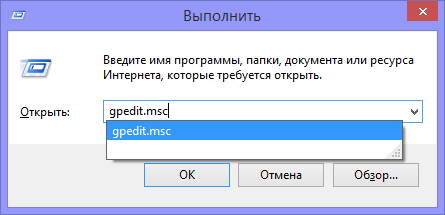
- Step 2. In the window that expands, go to " Computer configuration", Then" Administrative Templates", Then" System"And further in" Access to removable storage devices". In the window on the right, find the line “ Removable discs: Prohibit recording»And carefully look at her condition. If recording prohibition is activated, then double-click on the line to bring up the menu, and set the status to “ Disabled". To complete, click the " OK».
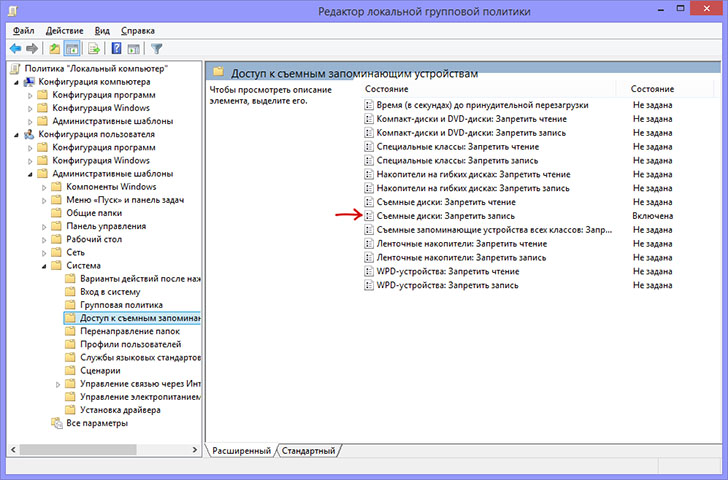
- Unfortunately, the standard windows tools can not always solve this problem. Sometimes you have to resort to third-party utilities created for restoring and formatting USB-drives. It is best to use the utilities, the disc with which is sold complete with a flash drive. But if you do not have it, you can use the program HUDS Format Toolwhich you can.
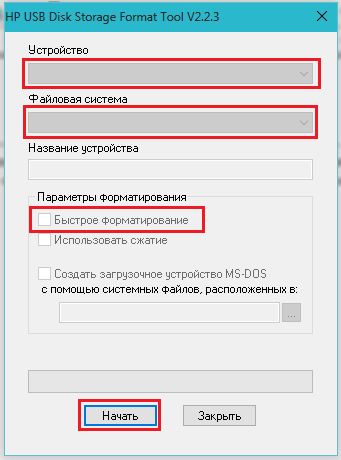
- To format the USB flash drive using this program, connect the USB flash drive to the computer, download and run the program. In the window that opens, select your device from the list, set the file system format to " NTFS", Put a tick in front of the line" Fast formatting"And click" To begin". After the formatting process is completed, the flash drive should again become usable.
- If none of the above methods helped you, then most likely the problem lies in physical damage to the device and the only way out of this situation is to purchase a new USB flash drive or memory card.
The era of floppy disks is long gone, but sometimes when trying to write to a flash drive, the user may encounter a situation known since the days of using flexible media - it is blocked and cannot be used.
How to solve this problem, we consider in detail in our today's article.
So, you need to write some information on a USB flash drive, you insert it and get a message like "The disc is write protected, unprotect or use another one".
This problem it can be resolved rather quickly, and we will talk about this a little later, but now we should say a few words about the purpose for which the protection from downloading is set to.
Note! This operation is performed with only one purpose - that can spontaneously be copied to removable media without the user's knowledge.
Ways to remove write protection from a USB flash drive
There are 2 key ways to remove protection from a flash drive: hardware and software.
The hardware solution is to install a lock switch, which is present in some models of drives, as well as SD cards. Most often the toggle switch is located on the side edge of the drive.
Carefully inspect the existing drive and find on it the icon of an open / closed lock or the inscription Lock.
Note! It is very easy to remove the lock - move the lock lever in the opposite direction. That's all. Insert the media into the appropriate slot and repeat the write operation again.
The software solution involves the interaction and controller of the flash drive, which is responsible for the ability to record information.
You can remove write protection using this method using the command line of the registry editor or local group policy. More guidance on all the above methods.
We remove the protection with regedit
1. Click "Start", in the search field enter -. Right-click (PCM) on the program and in the context menu go to the “Run as administrator” item.
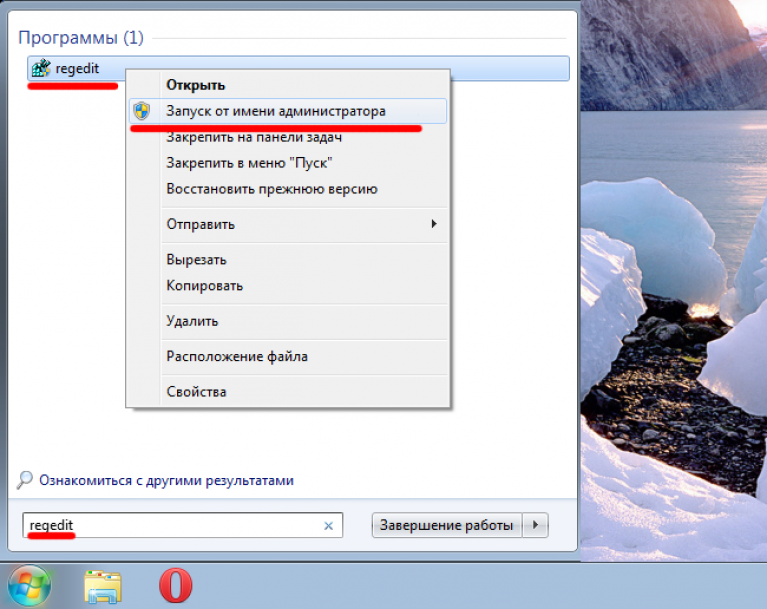
2. Go to the StorageDevicePolicies section:
HKEY_LOCAL_MACHINE \\ SYSTEM \\ CurrentControlSet \\ Control \\ StorageDevicePolicies
Important!Important! If there is no such thing, you will have to create it. To do this, click on the section Control - Create - Section. Call it "StorageDevicePolicies" without quotes. If there is no such section, you need to create it.

Create (PCM in the right column of the registry) parameter DWORD (32 bits) in the created branch. For convenience, let's call the element WriteProtect.
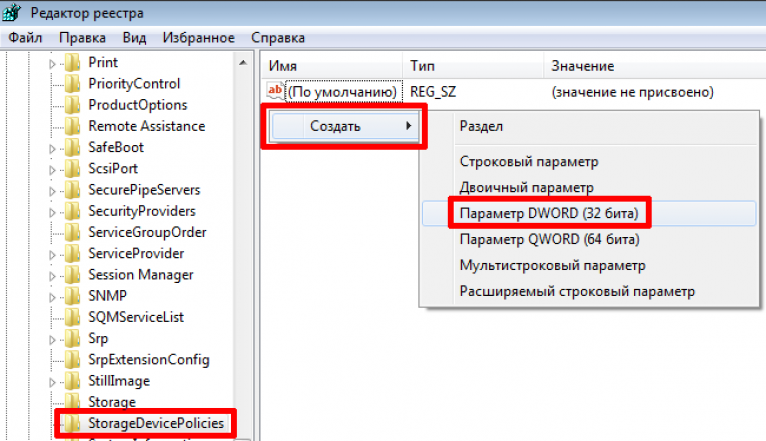
3. You should make sure that the WriteProtect value is 0. We click the RMB on WriteProtect, select "Change". If the value “1” needs to be changed to “0” and click “OK”.
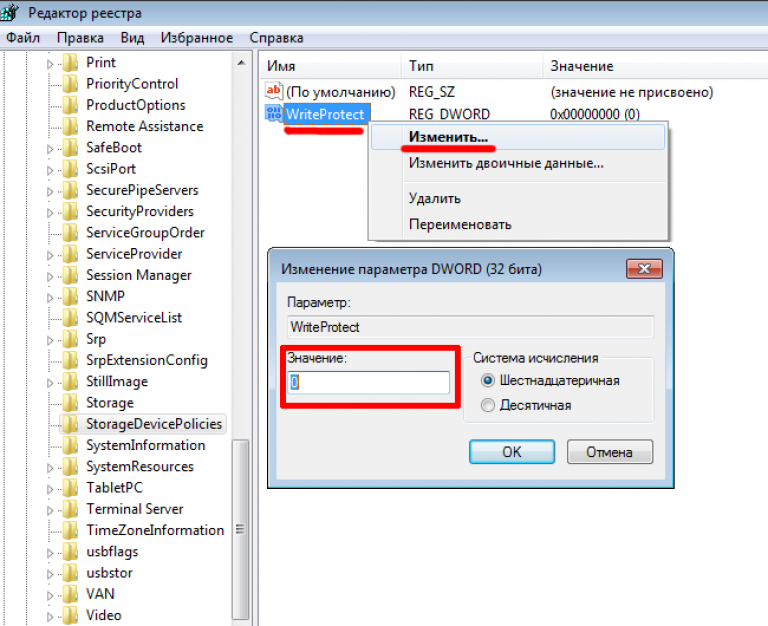
4. Close the registry editor, remove the media and reboot the computer. Insert the flash drive. Now the flash drive works as usual, allowing you to write files.
Removing protection with Diskpart
If it was not possible to unblock using regedit, we will try to do it using the Diskpart command interpreter, which allows you to manage the commands that the user enters into the command line when working with partitions and disks.
1. “Start”, in the search field enter the name - cmd. Click RMB in the program, in the context menu, we run "Run as administrator".
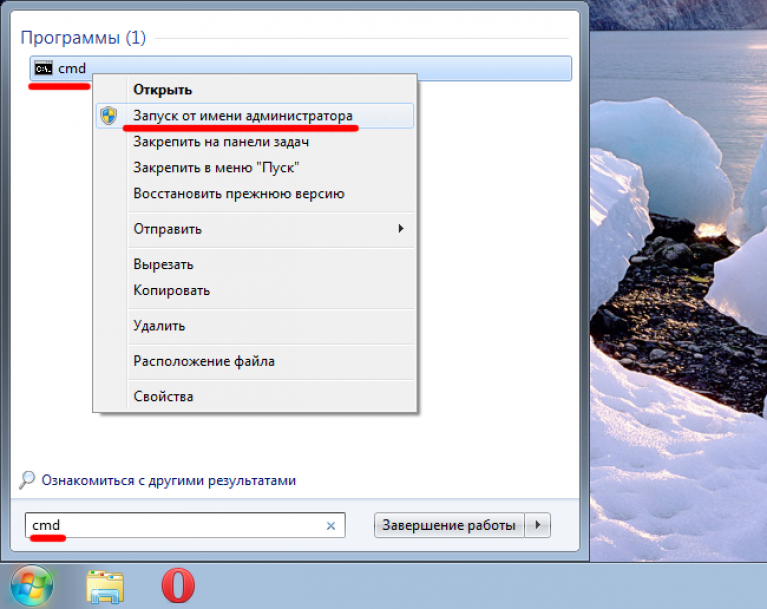
2. Now enter the commands: diskpart and list disk, and after entering each of them, press the Enter key.
3. In the above list, determine which sequence number in the title has a flash drive.
This can be done by referring to the specified size, in our case a 8 GB flash drive, is presented in the table as “Disk 1” with a volume of 7441 MB.
4. Select the disk with the command “select”, clear the attributes that allow only reading “attributes disk clear readonly”.
If you need to enter the following commands: “clean”, create a partition “create partition primary”, format it in NTFS “format fs = ntfs” or FAT “format fs = fat”.
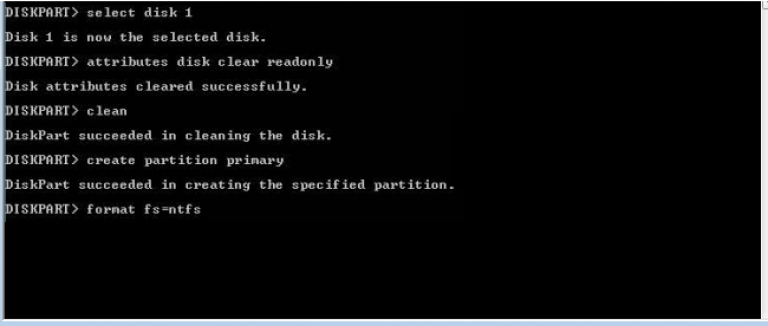
Over the past month, I have 2 times brought MicroSD flash drives with the same problem: when I try to copy some file or folder to it, delete or move it to another location, I get the error "The disk is write protected." They were used in the car video recorder. As it turned out later, he had a very sensitive G-sensor and when the wheel hit the hole or pothole, the overwrite protection function worked, which also apparently did not work quite correctly. The same thing can happen not only with SD and MicroSD memory cards, but also with ordinary USB flash drives. Sometimes this can serve as an indicator of device malfunction, but, fortunately, not always. In some cases, this annoying trouble turns out to be successfully eliminated. Therefore, now we will talk about how to remove write protection from a flash drive or memory card, if it writes “Disk is protected”.
1. Formatting a disk
This is the easiest way to remove write protection in most cases. True, the usual way through the conductor to do this is likely to fail. Therefore, we look at the drive letter, which is attached to the drive. Then we press the key combination Win + R and in the Run window we write the command:
Format<буква_диска>: / q
Or with the file system:
Format<буква_диска>: / q / fs: fat32
In my case, the letter “H” is used for the USB disk and it should work like this:

Click on "OK". A black command window should appear. windows stringsin which the drive will be formatted. When the process is complete, the window will automatically close. Check if record is available.
You can also try to format the USB flash drive using special utilities. For these purposes, I can recommend the application:

As a rule, she copes with the task. In addition, also completely free. You can also try to search for similar programs on the device manufacturer’s website. Vendors usually put them in free access in order to make life easier for consumers. One of these is JetFlash Recovery Tool. It allows you to recover removable disks not only from JetFlash, but also Transcend and A-Data, including removing write protection.
2. Hardware write lock
On many models of SD and SDHC memory cards, you can find a slider on the side of the case, signed as “Lock”. This is a hardware switch that allows you to put a write protection on the USB flash drive and, thus, protect data from possible deletion:
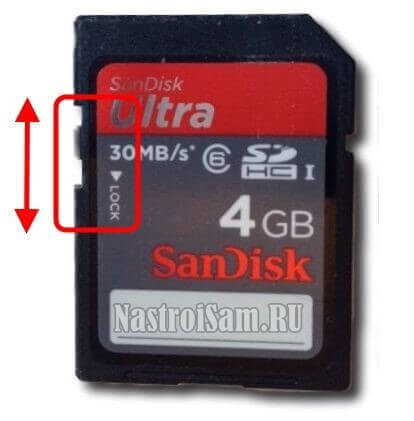
On USB flash drives, such a lock is rare. Basically, these are either old models of drives, or ordered directly from China through Aliexpress.

Among the well-known brands I met such a switch only on QUMO and Apacer. Nevertheless, carefully inspect your flash drive for its possible presence. If such is present - slide it towards the icon in the form of an open lock.
3. Windows crash or viral activity
In my memory there were several cases when a user managed to pick up a virus, which, among other things, also blocked flash drives. And it can be done in Windows 7.8 or 10 in several ways. Check out both of them.
— Local Policies access
Press the key combination Win + R and in the Run window enter the command gpedit.msc. Click on "OK" and we will open the Local Group Policy Editor. In it you need to open a group: User Configuration \\ Administrative Templates \\ System \\ Access to Removable Storage Devices. It will have the item “Removable Discs: Disable Recording”.
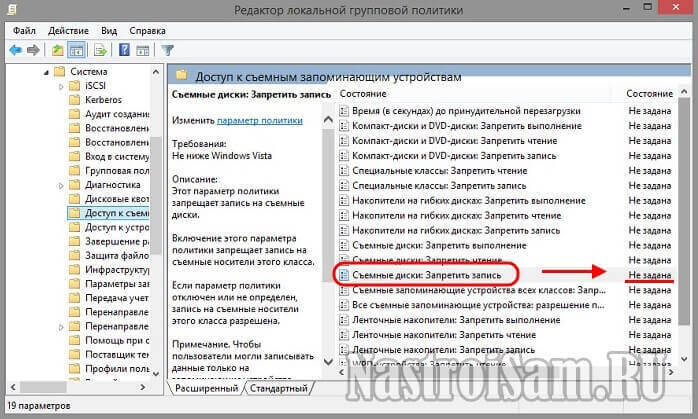
By default, the policy should not be set, as in the screenshot. If there is a different value there - double click on the parameter and set the value to “Not set”.
- Windows Registry
The message “Disk is write-protected” may also appear because the system registry setting prohibits making changes. To check this you need to open the Registry Editor. Press the "Start" button and enter the word in the search regedit. On the found tab, click the right mouse button and in the menu that opens, select the "Run as Administrator" item:
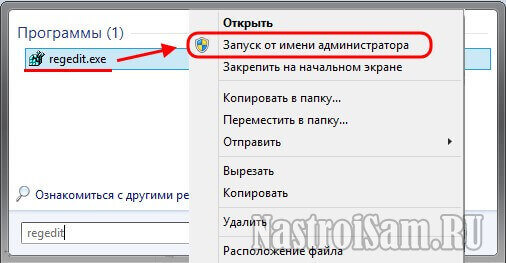
In the editor window that opens, you need to find a branch:
HKEY_LOCAL_MACHINE \\ System \\ CurrentControlSet \\ Control \\ StorageDevicePolicies
Open it and see what lines there are:
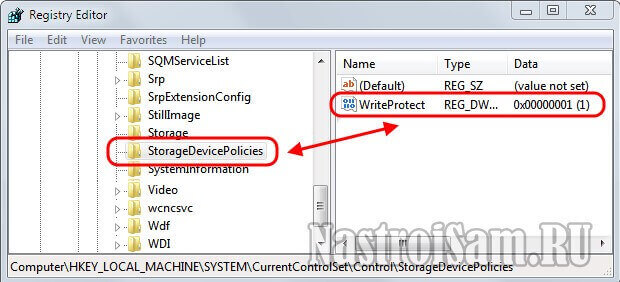
If there is a WriteProtect key - look at its value:
1 - enable change lock
0 - disable write protection for flash drives
If the unit is set, change to zero and reboot.
Note:
In Windows XP, you need to search for the WriteProtect key in the branch:
HKEY_LOCAL_MACHINE \\ System \\ CurrentControlSet \\ Services \\ USBSTOR
4. Attribute Read-Only
Another option that also takes place is to block the recording on a removable disk using the attribute Read-Only. It, in essence, has no relation to the file system of the drive, but simply indicates to Windows that the disk is write-protected and changing its contents is prohibited. That is why this attribute is very fond of any malicious program animals. To remove it, you need to run a command prompt with administrator rights and enter in turn the following:
diskpart
list disk
The last command will list the available drives. We find our own in it removable drive and choose it. In my example, this is disk 2:
select disk 2
A confirmation should appear that it is selected. After that enter the command:
attributes disk clear readonly
Press the "Enter" key and wait for the procedure to complete.

After that, lock the flash drive from the record should be successfully removed.
P.S. I almost forgot to tell you about this. If one day you are faced with the fact that the message "Disk is write-protected" is issued when you try to copy something to your sSD, most likely the reason is that the device has switched to emergency mode. This happened due to the fact that the limit of rewriting cycles was reached. After that, the SSD-drive will be available in read-only mode. Write something not him fail.
